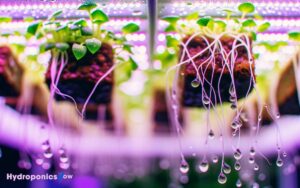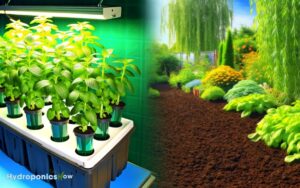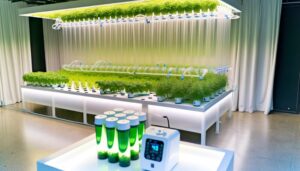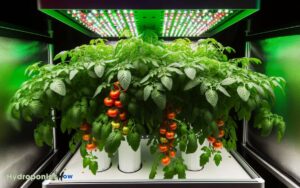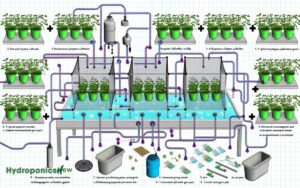Does Different Amounts of Water Affect Hydroponic Plant? Yes
Yes, different amounts of water have a significant impact on hydroponic plants. Water serves as the primary medium for nutrient delivery and sustains plant health.
Overwatering can cause root hypoxia, stunted growth, and lead to diseases. Underwatering, on the other hand, hampers nutrient absorption and root development.
Precise water management, tailored to each plant’s growth stage, is essential. Monitoring pH levels between 5.5 and 6.5, maintaining balanced nutrient solutions, and ensuring sufficient oxygen are vital practices.
Systems like NFT, DWC, and aeroponics can optimize plant growth by managing water flow and oxygen supply. Learn more about these techniques and best practices.

Key Takeaways
Importance of Water in Hydroponics
Water, being the primary medium for nutrient delivery in hydroponics, is essential for the ideal growth and health of the plants. It ensures that essential minerals dissolve and become readily available to the plant roots.
You need to maintain precise pH levels, typically between 5.5 and 6.5, to optimize nutrient absorption. EC (Electrical Conductivity) should be monitored to maintain balanced nutrient concentrations.
Inconsistent water quality or quantity can lead to nutrient imbalances, affecting plant metabolism and growth rates. Regularly testing water for contaminants like chlorine and heavy metals is important.
Water Requirements for Different Plants
Understanding how different plant species have varying water needs is pivotal to optimizing your hydroponic system’s efficiency and ensuring robust plant growth.
Each plant type has specific water uptake requirements influenced by its physiology and growth stage. By tailoring water delivery, you can enhance nutrient absorption and prevent water stress.
Consider these common plants and their water demands:
- Lettuce: Thrives with frequent, moderate watering to maintain a moist but not waterlogged environment.
- Tomatoes: Require consistent moisture but benefit from occasional dry periods to promote root growth.
- Herbs (e.g., basil, mint): Prefer slightly lower water levels, preventing root rot while supporting aromatic foliage development.
Accurately gauging your plants’ water needs will lead to more effective hydroponic management and healthier yields.
Ideal Water Levels
You need to maintain a balanced water level to guarantee hydroponic plants thrive. Research indicates that overwatering can lead to root hypoxia, which stunts growth and increases susceptibility to diseases.
Optimal Water Balance
Achieving the ideal water balance in hydroponic systems requires precise monitoring and adjustment to guarantee plants receive the exact hydration needed for maximum growth.
You must consider several factors to optimize water levels effectively:
- Nutrient Solution Concentration: Guarantee the nutrient solution is balanced to prevent nutrient deficiencies or toxicities.
- Water pH Levels: Maintain the water pH between 5.5 and 6.5 for peak nutrient uptake.
- Oxygen Supply: Ensure sufficient oxygen is dissolved in the water to support root respiration.
Overwatering Risks Analysis
Overwatering in hydroponic systems can lead to root rot, nutrient imbalances, and diminished oxygen levels, all of which compromise plant health and growth.
You must maintain ideal water levels to avoid these issues. Evidence shows that plants require a delicate balance between water and oxygen. Excess moisture suffocates roots, reducing nutrient uptake and leading to diseases.
Here’s a quick reference table to help you identify overwatering risks and ideal water levels:
| Symptom | Cause |
|---|---|
| Root Rot | Excess Water |
| Yellowing Leaves | Nutrient Imbalance |
| Wilting Despite Water | Oxygen Deficiency |
| Stunted Growth | Poor Root Health |
Overwatering Risks
Excess water in hydroponic systems can lead to root rot, stunted growth, and nutrient deficiencies.
When plant roots are submerged in too much water, oxygen availability decreases, promoting harmful anaerobic bacteria. You need to balance water levels to avoid detrimental effects.
Key overwatering risks include:
- Root Rot: Oxygen-deprived roots are susceptible to pathogens like Pythium, causing decay and plant death.
- Stunted Growth: Overwatered plants can’t uptake nutrients efficiently, leading to reduced growth rates.
- Nutrient Deficiencies: Excess water dilutes nutrient concentration, impairing absorption and leading to deficiencies.
Monitoring water levels and ensuring proper aeration can mitigate these risks. Utilize sensors and regular checks to maintain an ideal environment for plant health.
Underwatering Consequences
When you don’t provide sufficient water in hydroponic systems, plants can experience wilting, nutrient lockout, and slowed growth. This can weaken the plants and make them more susceptible to diseases and pests. Additionally, an imbalance in nutrient uptake may occur, leading to issues such as too much phosphorus in hydroponics, which can interfere with the absorption of other essential nutrients like iron and zinc. Maintaining proper water levels is crucial to ensuring optimal plant health and growth.
Wilting occurs because the plant’s cells lose turgor pressure, a critical factor for maintaining structure.
Nutrient lockout happens when inadequate water prevents the efficient uptake of essential minerals, leading to deficiencies.
Slowed growth is a direct consequence of these factors, as the plant’s metabolic processes become impaired.
Evidence suggests that even slight water deficits can disrupt photosynthesis and root development.
Studies highlight that essential water levels are vital for sustaining hydroponic plant health. Regular monitoring and accurate adjustments are necessary to prevent these adverse outcomes.
Balancing Water and Nutrients
To achieve peak growth, you’ll need to maintain precise water levels and the correct nutrient solution ratio. Studies show that improper balances can lead to nutrient deficiencies or root rot.
Optimal Water Levels
Balancing water and nutrients is crucial for maximizing the growth of hydroponic plants, ensuring they receive the precise amounts needed for peak health. You need to maintain ideal water levels to facilitate efficient nutrient uptake and oxygen availability.
Here’s what to keep in mind:
- Water Oxygenation: Guarantee the water is adequately oxygenated to prevent root hypoxia.
- Consistent Monitoring: Regularly check water levels to avoid fluctuations that can stress plants.
- Water Quality: Use clean, pH-balanced water to prevent nutrient lockout and ensure effective absorption.
Nutrient Solution Ratio
Equally important as maintaining ideal water levels is ensuring the correct nutrient solution ratio to support hydroponic plant health.
You need to balance macro-nutrients (N-P-K: Nitrogen, Phosphorus, Potassium) and micro-nutrients (iron, manganese, zinc) to support optimal growth. Using empirical data, you can fine-tune this ratio to match your plant species and growth stage.
Here’s a simplified guideline:
| Growth Stage | N-P-K Ratio | Micro-nutrients (ppm) |
|---|---|---|
| Seedling | 2-1-2 | 0.5 – 1.0 |
| Vegetative | 3-1-2 | 1.0 – 2.0 |
| Flowering | 1-2-3 | 1.5 – 2.5 |
Implementing a balanced nutrient solution helps you avoid deficiencies and toxicities, promoting vigorous and healthy plants. Regularly monitor and adjust your solution to maintain these ratios.
Preventing Root Rot
Guaranteeing proper oxygenation of the root zone is crucial to preventing root rot in hydroponic systems. You must balance water and nutrient levels to maintain healthy roots and avoid fungal infections.
Oxygenation helps roots absorb nutrients efficiently and prevents anaerobic conditions where harmful pathogens thrive.
To achieve this:
- Aerate the nutrient solution: Use air pumps or stones to introduce oxygen.
- Monitor root health: Regularly check for signs of discoloration or mushiness.
- Adjust watering cycles: Ensure roots are moist but not waterlogged.
Monitoring Water Quality
To achieve ideal plant growth in a hydroponic system, it’s crucial to regularly monitor and adjust the water’s pH, electrical conductivity, and nutrient levels. Start by measuring the pH; it should typically range between 5.5 and 6.5. Use a pH meter for accuracy.
Electrical conductivity (EC) gauges the nutrient concentration, with best levels varying by plant species but generally falling between 1.2 and 2.5 mS/cm. Use an EC meter to ensure nutrients are adequately dissolved.
Regularly test for nutrient imbalances, and adjust the solution composition as necessary. Consistent monitoring will prevent deficiencies and toxicities, fostering robust growth.
Document your readings and adjustments to track trends and make informed decisions. This methodical approach guarantees your plants receive the best possible care.
Impact on Root Health
You need to understand that water levels directly influence root oxygen levels, which are essential for plant health.
Ideal water amounts enhance nutrient absorption efficiency, ensuring robust growth.
Conversely, improper water levels can increase disease susceptibility, compromising root integrity.
Root Oxygen Levels
How do varying root oxygen levels impact the overall health of hydroponic plants?
Oxygen availability at the root zone is essential for best plant growth. Insufficient oxygen can lead to root hypoxia, stunted growth, and increased susceptibility to diseases. Conversely, adequate oxygen levels promote root respiration and nutrient uptake.
Key factors to take into account include:
- Aeration Techniques: Implementing air pumps or air stones can guarantee consistent oxygen supply.
- Water Temperature: Cooler water holds more dissolved oxygen, which benefits root health.
- Root Zone Maintenance: Regularly checking for root rot and ensuring proper drainage prevents oxygen deprivation.
Nutrient Absorption Efficiency
Frequently, nutrient absorption efficiency directly impacts root health in hydroponic systems by determining the availability of essential minerals and elements.
When water levels are optimized, roots can access necessary nutrients more effectively, promoting robust growth and function.
Studies show that inconsistent water amounts can lead to nutrient imbalances, hindering absorption efficiency.
You need to make sure that the water-to-nutrient ratio is meticulously calibrated; otherwise, roots might experience deficiencies or toxicities.
By maintaining consistent hydration levels, you enhance the root system’s ability to uptake nutrients, resulting in healthier plants.
Precise control over water delivery ensures that roots remain well-nourished, thereby supporting overall plant vitality and productivity.
Proper management of water levels is essential for maximizing nutrient uptake efficiency in hydroponic setups.
Disease Susceptibility
Consistent water levels in hydroponic systems greatly impact root health by reducing disease susceptibility. When you maintain stable hydration, roots can thrive and resist pathogens.
Variability in water levels can create stress, making plants more vulnerable to diseases like root rot and fungal infections.
Key benefits of consistent water levels include:
- Enhanced oxygenation: Proper water levels help roots receive enough oxygen, essential for preventing anaerobic conditions that foster disease.
- Optimal nutrient uptake: Consistent hydration allows roots to absorb nutrients efficiently, strengthening plant defenses.
- Balanced pH levels: Stable water levels assist in maintaining pH balance, deterring harmful microorganisms.
Water Circulation Systems
Water circulation systems play an essential role in hydroponic setups by ensuring that plants receive a steady supply of nutrients and oxygen.
You need to understand that these systems maintain ideal conditions by continuously moving water, preventing stagnation and promoting root health. Evidence shows that efficient water circulation reduces the risk of root diseases and enhances nutrient uptake.
Techniques like nutrient film technique (NFT), deep water culture (DWC), and aeroponics exemplify varied approaches to water circulation.
Each method has its own advantages based on plant type and growth environment. By maintaining appropriate flow rates and oxygen levels, you can optimize plant growth and yield.
Properly managing water circulation is critical for the success of your hydroponic system.
Adjusting for Plant Growth Stages
To optimize hydroponic plant growth, adjust the water and nutrient delivery based on the specific needs of each growth stage. During the seedling stage, plants require a high humidity environment and lower nutrient concentration to promote root development.
As they transition to the vegetative stage, increase both water flow and nutrient concentration to support robust leaf and stem growth.
Finally, during the flowering stage, adjust the nutrient mix to enhance bud development.
- Seedling Stage: High humidity, low nutrients
- Vegetative Stage: Increased water flow, higher nutrients
- Flowering Stage: Adjusted nutrient mix for buds
Practical Tips for Water Management
Implementing precise water management techniques guarantees ideal growth and health for your hydroponic plants. Regularly monitor water levels and adjust based on plant needs.
Use a reliable pH meter to maintain the best pH levels (5.5-6.5). Make sure nutrient solutions are refreshed weekly to prevent imbalances. Track evaporation rates, as they can vary with temperature and humidity.
Here’s a quick reference table:
| Aspect | Best Range |
|---|---|
| Water pH Level | 5.5 – 6.5 |
| Nutrient Solution | Refresh Weekly |
| Water Temperature | 65°F – 75°F |
| Light Exposure | 14-16 hours/day |
Conclusion
You’ll find that managing water levels in hydroponics isn’t just essential it’s coincidentally the linchpin of plant health.
Overwatering or underwatering can derail your efforts, affecting root development and overall growth. By precisely adjusting water based on plant requirements and growth stages, you’ll foster a thriving hydroponic system.
Remember, the science behind ideal water management is your ally, ensuring your plants flourish. Don’t overlook this; your vibrant garden depends on it.

